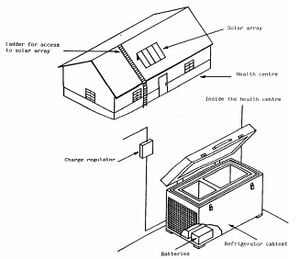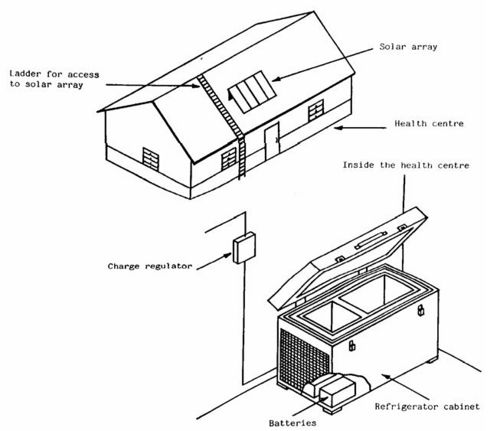
Extensive immunisation programmes are in progress throughout the developing world in the fight against the common communicable diseases. To be effective these programmes must provide immunisation services to rural areas.
Solar radiation tends to be high in climates that have great needs for cooling, a great deal of effort has been directed to develop solar powered refrigerators. Although some solar absorption (thermal) refrigerators have been developed only solar photovoltaic (electric) refrigerators have so far proved reliable.
Solar photovoltaic power for refrigerators has great potential for lower running costs, greater reliability and a longer working life than kerosene refrigerators or diesel generators, which have been generally used in remote areas. Over the past five years, at least 3000 photovoltaic medical refrigerators have been installed.
The need[edit | edit source]
All vaccines have to be kept within a limited temperature range throughout transportation and storage. The provision of refrigeration for this, known as the Vaccine 'Cold Chain', is a major logistical undertaking in areas where electricity supplies are non-existent or erratic. The performance of refrigerators fuelled by kerosene and bottled gas is often inadequate. Diesel powered systems frequently suffer fuel supply problems. Solar power is therefore of great importance to health care. Relative merits of using photovoltaic refrigerators Compared to kerosene or bottled gas fuelled refrigerators, photovoltaic systems have the following advantages:
Improved vaccine storage facilities as a result of[edit | edit source]
- elimination of fuel supply problems
- elimination of fuel quality problems
- greater refrigerator reliability
- better refrigerator performance (and temperature control)
Reduced running costs as a result of[edit | edit source]
- elimination of kerosene fuel costs
- elimination of kerosene transportation costs
- reduced vaccine losses
- lower refrigerator maintenance costs
- reduced needs for back-up refrigerators where there are fuel supply or repair problems
Cold chain management benefits due to[edit | edit source]
- longer equipment life (photovoltaic array 15 years, battery 5 years refrigerator 10 years)
- reduced logistical problems arising from non-availability of working refrigerators
- reduced logistical problems arising from lower vaccine losses.
The above operational advantages of introducing solar refrigerators into the cold chain indicate that solar refrigerators can provide a more sustainable vaccine cold chain.
It should be noted however, that as each system is site specific, more time is necessary for planning and implementing a project with solar refrigerators.
User training demands are also higher since a new technology is being introduced.
Comparative costs[edit | edit source]
A true comparison of solar refrigerators and comparable kerosene and bottled gas fuelled refrigerators can only be made through a life-cycle cost analysis. A solar photovoltaic refrigerator cabinet only is likely to cost around US $1300 - 2600 (with the complete system costing around US $3000 - 5000) and will cost more to install than a kerosene unit. A kerosene refrigerator will cost only US $650 - 1300 but will use 0.5 - 1.4 litres of fuel per day, require frequent maintenance and have a shorter life. In general, life-cycle costs are approximately the same for solar and kerosene refrigerators, but because of their greater reliability and resultant savings in wasted vaccine, solar refrigerators are the preferred option.
The technology[edit | edit source]
Refrigerator[edit | edit source]
Photovoltaic refrigerators operate on the same principle as normal compression refrigerators but incorporate low voltage (12 or 24v) dc compressors and motors, rather than mains voltage ac types. A photovoltaic refrigerator has higher levels of insulation around the storage compartments to maximise energy efficiency, a battery bank for electricity storage, a battery charge regulator and a controller which converts the power from the battery to a form required by the compressor motor.
A typical refrigerator layout is as shown below (Figure 1). Most refrigerators include a freezer compartment for ice pack freezing. Other systems have separate units to provide solely for refrigeration or freezing. Available sizes range between 10 and 85 litres of vaccine storage capacity with ice production rates of up to 6.4 kg per 24 hours.

Batteries[edit | edit source]
The battery most commonly used is the lead acid type, long life, deep cycle batteries are preferred. A capacity to run the refrigerator for five days without sun is recommended.
Charge regulator[edit | edit source]
The charge regulator maintains the power supply within the current and voltage range tolerated by the refrigerator and prevents overcharge of the battery. Some models include an audible alarm or warning light to signal when battery voltage becomes low. Lightning surge protection must be provided for tropical areas.
Array and support structure[edit | edit source]
The solar array can be for roof or ground mounting. The array size for a refrigeration system is calculated to meet the power requirements of the system, given the solar irradiance data for the proposed site. The typical requirement is 150 - 200 Wp of photovoltaic modules.
Performance[edit | edit source]
The energy consumption of a photovoltaic vaccine refrigerator is typically 400 - 800 watt-hours per 24 hours for a 100-litre refrigerator without icepack freezing and at +32°C ambient temperature. At +43°C ambient temperature and freezing 2kg of ice packs per 24 hours the energy consumption of the same refrigerator would rise to about 900 - 1900 watt-hours per 24 hours. It is very important not to overload a solar refrigerator as this increases energy consumption considerably.
A good vaccine refrigerator should be able to maintain correct internal temperatures for at least ten hours in the event of being disconnected from the battery and solar array.
Costs[edit | edit source]
The output of a photovoltaic array will vary according to the location at which it is to be installed and the refrigerator energy consumption will depend on local climate. Therefore the size of the solar array, the battery storage capacity and hence the system cost will vary depending on location. Typical system costs are in the range of US $3,500 - 7500 excluding transport and installation.
Products available[edit | edit source]
The Department of Vaccines and Biologicals of the World Health Organisation, in its Immunisation Systems Series publishes, every two years, a document entitled 'Product Information Sheets'. This catalogues equipment that has undergone tests to verify their performance is of a standard acceptable to the World Health Organisation (WHO) and United Nations Children Fund (UNICEF). The document may be obtained from: The V & B Document Centre, Department of Vaccine and Biologicals, World Health Organisation, CH-1211 Geneva 27, Switzerland. (Website: http://web.archive.org/web/20140128095210/http://www.who.int:80/vaccines-documents/, email: vaccines@who.int)
Suppliers[edit | edit source]
Note: This is a selective list of suppliers and does not imply Practical Action endorsement or promotion.
- Dulas Ltd., Dyfi Eco Park, Machynlleth, Powys - SY20 8SX - United Kingdom - Tel: +44 1654 705 000 - Fax: +44 1654 703 000 - Email: solar@dulas.org.uk - Website: dulas.org.uk/
- Bright Light Solar - The Old School - Eglwysfach - Machynlleth - SY20 8SX - United Kingdom - Tel & Fax: +44 (0)1654 781 241 - Email: ian.tansley@brightlightsolar.com - Website: http://www.brightlightsolar.com
- Naps Systems Oy - Pakkalankuja 7 - 01510 Vantaa - Finland - Tel. +358 20 7545 666 - Fax +358 20 7545 660 - Email: sales@napssystems.com - Website: http://www.napssystems.com/
- Dometic (Luxembourg) - 17 op der Hei, L-9809 Hosingen - Luxembourg - Tel: +35 2 92 07 31 - Fax: +352 920 731 300 - Email: pascal.vannier@dometic.lu - Website: www.dometic.lu
- Huurre Group Oy - P. O. Box 127 - 33101 Tampere - Finland - Tel: +358 20 55 55 11 - Fax: +358 20 55 55 288 - Email: export@huurre.com - Website: http://www.huurre.com
- Norcoast Refrigeration Co, 50 Grigor Street, - Caloundra, Queensland 4551, Australia - Tel: +61 7 9491 1849 - Fax: +61 7 5491 7627 - Website: http://www.norcoast.com.au
- Solamatics (Pvt) Ltd. - 31 Edison Road, Graniteside, Harare - Zimbabwe - Tel: +263 4 749 930 - Fax: +263 4 771 212 - Email: derrick@harare.iafrica.com
- Sun Frost - PO Box 1101, 824 St Ste # 7, Arcata, - California 95518, USA - Tel: +1 707 822 9095 - Fax: +1 707 822 6213 - Email: international@sunfrost.com - Website: http://www.sunfrost.com/vaccine_refrigerators.html
- Jewett Refrigeration Inc. - 275 Aiken Road - Ashebille - NC 28804 - USA - Tel: +1 828 658 2845 - Fax: +1 828 645 9466 - Website: http://web.archive.org/web/20190922145906/http://www.jewettonline.com:80/
- Vestfrost A/S - Spangsbjerg Mollevej 100 - DK-6705 Esbjerg O - Denmark - Tel: +45 79 142222 - Fax: +45 79 142355 - Email: bjarne.nielsen@vestfrost.dk - Website: http://www.vestfrost.com/
- Sibir International - Torggatan 8 - S-171 54 Solna - Sweden - Tel: +46 8 501 025 08 - Fax: +46 8 501 025 98 - Email: info.sibir@dometic.se - Website: http://www.sibir.com/
- Zero Appliances(PTY) Ltd. - Mission Terrace - Chloorkop Ext 44 - Kempton Park - South Africa - Tel: +27 11 393 4140 - Fax:+27 11 393 4119 - Email: zero@elink.co.za -